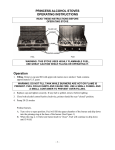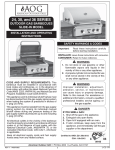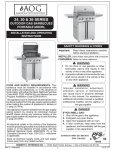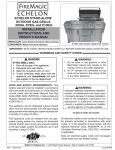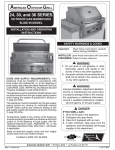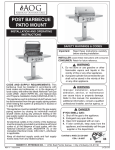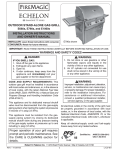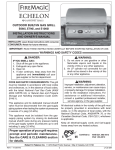Download AOG Post barbecue patio mount Operating instructions
Transcript
RE FE RE NC E AMERICAN OUTDOOR GRILL POST BARBECUE PATIO MOUNT INSTALLATION AND OPERATING INSTRUCTIONS INSTALLER: Leave these instructions with consumer. CONSUMER: Retain for future reference. IMPORTANT: READ THESE INSTRUCTIONS CAREFULLY BEFORE STARTING INSTALLATION SAFETY WARNINGS & CODES DANGER: IF YOU SMELL GAS: 1. 2. 3. 4. WARNING: 1. Do not store or use gasoline or other flammable vapors and liquids in the vicinity of this or any other appliance. 2. An LP cylinder not connected for use shall not be stored in the vicinity of this or any other appliance. Shut off the gas to the appliance. Extinguish any open flame. Open lid if equipped with an oven. If odor continues, keep away from the appliance, and Immediately call your gas supplier or Fire Department. WARNING Improper installation, adjustment, alteration, service or maintenance can cause injury or property damage. Refer to this manual. For assistance or additional information consult qualified, professional installer, service agency, or the gas supplier. CODE AND SUPPLY REQUIREMENTS: This barbecue must be installed in accordance with local codes and ordinances, or, in the absence of local codes, with either the latest National Fuel Gas Code (ANSI Z223.1/NFPA 54), Natural Gas and Propane Installation Code (CSA B149), Propane Storage and Handling Code (CSA B149.2). Certified to ANSI: Z21.58 This appliance and its individual shutoff valves must be disconnected from the gas supply piping system when testing the system at pressures in excess of ½ psig (3.5 kPa). All electrical outlets in the vicinity of the barbecue must be properly grounded in accordance with local codes or, in the absence of local codes, with the National Electrical Code, ANSI/NFPA 70, or the Canadian Electrical Code, CSA C22.1 which ever is applicable. This appliance must be isolated from the gas supply piping system by closing its individual manual shutoff valves during any pressure testing of the gas supply system at pressures up to and including ½ psig (3.5 kPa). Keep any electrical supply cord and the fuel supply hose away from any heated surfaces. American Outdoor Grill • PO Box 4053 • La Puente, CA 91747 REV 5 - 0603071230 1 L-C2-21306 TABLE OF CONTENTS 1 2 2 3 4 4 4 4 4 4 4 4 4 5 5 5 6 7 8 8 9 9 10 10 10 10 11 11 11 12 13 13 13 13 13 13 14 RE FE RE NC E SAFETY WARNINGS & CODES TABLE OF CONTENTS PRODUCT DATA TABLE PARTS LIST PLANNING THE LOCATION OF YOUR POST BARBECUE INSURING PROPER COMBUSTION AIR AND COOLING AIR FLOW ELECTRICAL OUTLETS EXHAUST REMOVAL SECURING THE POST BARBECUE GAS SUPPLY REQUIREMENTS GAS SUPPLY PLUMBING REQUIREMENTS CONNECTING TO THE GAS SUPPLY GAS SUPPLY AND MANIFOLD PRESSURES SAFE USE & MAINTENANCE OF PROPANE GAS CYLINDERS CYLINDER AND CONNECTOR REQUIREMENTS AND SPECIFICATIONS QUICK COUPLER OPERATION CHECKING AND CONVERTING YOUR BARBECUE MAIN BURNER ORIFICE SIZE CHECKING/CONVERSION BACKBURNER ORIFICE SIZE CHECKING/CONVERSION SIDEBURNER ORIFICE SIZE CHECKING/CONVERSION AIR SHUTTER ADJUSTMENT RIGID SHELF INSTALLATION BARBECUE SAFETY INFORMATION & MAINTENANCE DRIP COLLECTION SYSTEM REPLACING THE IGNITOR BATTERY SETTING THE TIMER LIGHTING (IGNITION) INSTRUCTIONS MANUAL LIGHTING ADJUSTING THE FLAME TROUBLESHOOTING CARE AND CLEANING CARE OF STAINLESS STEEL COMPONENTS BURNER INSPECTION AND MAINTENANCE STAINLESS STEEL COOKING GRIDS PORCELAIN COATED CAST-IRON GRIDS PROTECTING PARTS AND FINISH AMERICAN OUTDOOR GRILL LIMITED WARRANTY PRODUCT DATA TABLE Specification Main Burner BTUs Natural Gas Orifice Propane Gas Orifice Backburner BTUs Air Shutter Opening Natural Gas Orifice Propane Gas Orifice Value Sideburner BTUs Natural Gas Orifice Propane Gas Orifice Air Shutter opening 42,000 #46 (part# 3001-46 ) 1.20mm (part# 3001- 120) 15,000 #53 (part #3001-53) #63 (part #3001-63) 1/8-inch(NAT & LP) 10,000 1/8-inch (NAT & LP) #54 (part# 3001-54) #65 (part# 3001-65) Table 1 - Product Data Table REV 5 - 0603071230 2 L-C2-21306 PARTS LIST Item Description IMPORTANT 1. COOKING GRID 18" X 11.5"/18 BARS (2) 2. FLAVOR GRID, 15.5" X 11.5" (2) 3. BURNER, 15.75" X 5" (2) 4. LID, OVEN AOG BBQ 24" WELD ASSEMBLY 5. SIDE BURNER W/ SHELF, AOG ASSEMBLY 6. SHELF, AOG CART W/ DOOR 7. 24" AOG, POST INNER LINER W/ SB ASSEMBLY 8. AOG, POST BASE 9. 24" AOG, VALVE MANIFOLD SB ASSEMBLY or 24" AOG, VALVE MANIFOLD SB ASSEMBLY Your AOG Barbecue, Oven and Backburner are fully Pre-assembled and tested at the factory. RE FE RE NC E DO NOT attempt to remove the oven and Backburner from the Barbecue prior to or during installation. Damage to the connecting gas line and ignitor wiring may occur. 10. QUICKLIGHTER, 4 SPARK IGNITOR 11. FACE, 24" AOG BBQ WELD SB ASSEMBLY) 12. KNOBS, FIRE MAGIC BBQ (2) 13. KNOBS, FIRE MAGIC BACKBURNER (2) 14. DRIP TRAY, ASSEMBLY 15. BACKBURNER, AOG BBQ 16. LAG SCREW 1/4" X 1.5 LG ZINC COAT (4) 17. LAG SHIELD LONG 1/4" X 1.5 (4) 18. AOG, POST BASE The plastic straps which secure the oven to the Barbecue unit should be removed and discarded prior to lighting. 1 2 Replacement parts can be ordered from your local American Outdoor Grill dealer. 3 15 5 11 9 4 6 7 12 8 10 16 14 13 18 17 American Outdoor Grill • PO Box 4053 • La Puente, CA 91747 REV 5 - 0603071230 3 L-C2-21306 PLANNING THE LOCATION OF YOUR POST BARBECUE This Barbecue designed FOR OUTDOOR USE ONLY. DO NOT use this unit under unprotected flammable surfaces. DO NOT use this appliance inside a building, garage, or any other enclosed area. It must not be used in or on recreational vehicles or boats. IMPORTANT: This unit is NOT insulated and therefore during use it must be located with a minimum of 18" of side and back clearance from unprotected combustible materials such as wood, plastic, or stucco with wood framing. EXHAUST REMOVAL INSURING PROPER COMBUSTION AIR AND COOLING AIR FLOW RE FE RE NC E If installed or used under a patio roof, the cooking grid area should be fully covered by a chimney and exhaust hood. An exhaust fan with a rating of 1000 CFM (cubic feet per minute) Fig. 4-1 or more may be necessary Ventilation Diagram to efficiently remove smoke and other cooking by-products from the covered area. THIS UNIT SHOULD NOT BE LOCATED IN A FULLY ENCLOSED AREA OF ANY KIND. You must maintain proper air flow for the barbecue to perform as it was designed (Fig. 4-1). If airflow is blocked, overheating and poor combustion will result. Do not block the 1" front air inlet along the bottom of the face or more than 75% of the cooking grid surface with objects such as pans or griddles. Note: The 1" front air space allows access to the drip tray. ELECTRICAL OUTLETS All electrical outlets in the vicinity of the barbecue must SECURING THE POST BARBECUE be properly grounded. Important: The post base must be securely fastened to a stable, level surface using the lag Note: Keep electrical supply cords away from all screws and shields provided (p. 3) to heated surfaces. ensure the barbecue remains fixed and upright at all times. GAS SUPPLY REQUIREMENTS GAS SUPPLY PLUMBING REQUIREMENTS The gas must be hooked up so that it passes through the timer (and regulator if equipped) located in the post. To For natural gas or a household propane system, rigid 1/2", access the timer, unscrew and remove the access plate in or 3/4" black steel pipe, or local code approved pipe is the back of the post using a No. 3 Phillips-head screwdriver. required to conduct the gas supply to the unit. An outdoor Retain the screws. access plate approved flexible connector can be used to connect your household gas supply to the barbecue. DO NOT use a To connect through the post, rubber hose within the enclosure for the barbecue remove the knock-out disk unit. Apply only joint compounds that are resistant to at the bottom of the access grommet (installed) all gasses on all male pipe fittings. Make sure to tighten plate with a large standard every joint securely. screwdriver by inserting the Fig. 4-3 Note: If 1/2" pipe is used with natural gas, it should be screwdriver into the notch knock-out provided in the center of the no longer than 20 feet. knock-out. Remove the plastic grommet fastened to the inside of the post and insert it into the newly created Important: An external valve (with a removable key) in the gas line is necessary for safety opening prior to passing the gas connection through the when the barbecue is not in use. It also opening. provides for convenient maintenance. To connect through the post base run the gas connection CONNECTING TO THE GAS SUPPLY through the hole provided in the center of the post base. Back of This post barbecue is Fig. 4-2 timer valve capable of connecting When finished, replace access Fig. 4-4 to the gas supply in plate and tighten the four Location of Flex regulator if a few different ways. connector screws provided. equipped The connection can be through hole (for Natural in base made inside the post, Gas only) GAS SUPPLY AND MANIFOLD PRESSURES under the post base, For Natural Gas - Normal 7" Water Column (w.c.), Minimum Grommet or out the back of the 5" w.c., Maximum 10 1/2" w.c. post. For Propane Gas - Normal 11" w.c., Minimum 8" w.c., post (access panel removed) Maximum 13" w.c. 4 SAFE USE & MAINTENANCE OF PROPANE GAS CYLINDERS READ AND FOLLOW ALL WARNINGS PROVIDED WITH YOUR PROPANE GAS CYLINDER. IMPORTANT FOR YOUR SAFETY When operating this appliance with a propane gas cylinder these instructions and warnings MUST be observed. FAILURE TO DO SO MAY RESULT IN A SERIOUS FIRE OR EXPLOSION. CYLINDER AND CONNECTOR REQUIREMENTS AND SPECIFICATIONS QUICK COUPLER OPERATION RE FE RE NC E To connect the regulator/hose assembly to the L.P. (propane) gas cylinder valve fitting: Press the hand nut on the regulator over the Acme thread fitting on the cylinder valve. Turn the hand nut clockwise to engage the threads and tighten until snug. The use of pliers or wrench should not be necessary. Only cylinders marked "propane" must be used. a. Propane gas cylinders and valves must be maintained in good condition and must be replaced if there is visible damage to either the cylinder or valve. b. This barbecue, when used with a cylinder, should be connected to a standard 5 gallon (20lb.) propane gas cylinder equipped with an OPD (Overfill Prevention Device). The OPD has been required on all cylinders To disconnect: Turn the hand nut counterclockwise until sold since October 1,1998 to prevent overfilling. detached. (Fig. 5-1). c. Cylinder dimensions should be approximately 12 inches in diameter and 18 inches high. Cylinders Important: Before using the barbecue and after each time the cylinder is removed and must be constructed and marked in accordance with reattached, check all connections for the specifications for LP-Gas Cylinders of the U.S. leaks. Turn off the barbecue valves and Department of Transportation (D.O.T.) or the National open the main cylinder valve, then check connections with soapy water. Repair any Standard of Canada,CAN/CSA-B339, Cylinders, leaks before lighting the barbecue. Spheres and Tubes for Transportation of Dangerous Goods. CAUTION: Always turn the propane cylinder main valve off after each use and before d. The cylinder must include a collar to protect the moving the barbecue and cylinder or cylinder valve and the cylinder supply system must disconnecting the coupling. This valve be arranged for vapor withdrawal. must remain closed and the cylinder disconnected while the appliance is not in e. The pressure regulator and hose assembly use, even though the gas flow is stopped (Fig. 5-1) supplied with this outdoor cooking gas by a safety feature when the coupler is appliance must be used. Original and replacement disconnected. pressure regulator and hose assemblies must be those specified by the Robert H. Peterson Co. Carefully inspect the hose assembly each time before for connection with a cylinder connecting device the gas is turned on. A cracked or frayed hose should be identified as Type I by the ANSI Z 21.58 and CGA replaced immediately. 1.6-M95-1995 with Addenda ANSI Z 21.58a -1998 If the appliance is stored indoors, the cylinder must be and CGA 1.6a - M98. disconnected and removed. Cylinders must be stored f. The propane gas cylinder valve must be equipped out of doors and out of the reach of children and with a cylinder connection coupling device, described must not be stored in a building, garage or any other as Type I in the standard defined in paragraph e. enclosed area. above. This device is commonly described as an FOR YOUR SAFETY 'Acme Thread Quick Coupler'. a. DO NOT store a spare propane gas cylinder under or near this appliance. g. If your propane gas cylinder comes with a dust plug, place the dust cap on the cylinder valve outlet whenever the cylinder is not in use. Only install the type of dust cap on the cylinder valve outlet that is provided with the cylinder valve. Other types of caps or plugs may result in leakage of propane. b. NEVER fill the cylinder beyond 80 percent full. c. IF THE INFORMATION IN “a” AND “b” IS NOT FOLLOWED EXACTLY, A FIRE CAUSING DEATH OR SERIOUS INJURY MAY OCCUR. Fig. 5-1 Type I Acme Thread Quick Coupler QCC Type 1 Handwheel Brass Acme Regulator Thread Fitting Valve Pressure Relief Valve UL Liquid Level Indicator Hand nut with ACME (optional) thread. 5 Vent Hose CHECKING AND CONVERTING YOUR BARBECUE WARNING This barbecue comes from the factory configured for HAZARDOUS OVERHEATING WILL OCCUR IF A one type of gas as marked on the label behind the NATURAL GAS ORIFICE IS USED WITH PROPANE GAS. IF YOU ARE NOT SURE THE CORRECT barbecue face plate. ORIFICES ARE INSTALLED, OR IF AN ORIFICE RE FE RE NC E Each burner has a replaceable brass orifice, which CHANGE IS NECESSARY, REFER TO THE FOLLOWING INSTRUCTIONS. must be checked during installation to verify a match to the gas being used. When converting the barbecue to a different gas, each burner’s orifice must be CAUTION: Make sure the barbecue is at a safe temperature and isolated from gas and checked and replaced with the corresponding orifice electrical supplies before beginning the for the new gas. tasks outlined below. Consult the model specifications table (page 2) under the specific gas to be burned, to determine the proper orifice sizes for each burner. Note: The cooler the barbecue, the greater the tolerances between the stainless steel parts and therefore the easier to disassemble and reassemble parts of the barbecue. For your safety, exercise caution, and make sure you have adequate hand protection such as gloves when handling removable sheet metal parts of the barbecue. CHECKING AND CONVERTING THE REGULATOR Barbecue regulator: note the cap on top Note: Each end of the plastic converter is engraved with either the letters “NAT” or “L.P.” for the respective gases. When the converter is in the cap and the cap is held uppermost, the letters seen indicate the gas that the regulator is set up for. To convert the regulator from one gas to another follow steps 1-4. STEP 1: Unscrew and remove the cap from the regulator, extracting the converter. STEP 2: READ GAS Remove the converter (the TYPE HERE plastic stalk) by carefully pulling it away from the center of the cap (it will snap out of its seating). STEP 3: Turn the converter around and replace carefully into the center of the cap (it will snap into place). Check that you can read the type of gas the unit is set for. STEP 4: Replace the unit into the regulator and screw down until snug. WARNING THIS APPLIANCE REGULATOR IS RATED FOR 1/2 PSI MAXIMUM. IF YOUR GAS SUPPLY IS GREATER THAN 1/2 PSI, AN ADDITIONAL REGULATOR MUST BE INSTALLED BEFORE THE BARBECUE. SEE GAS SUPPLY REQUIREMENTS SECTION FOR PROPER GAS SUPPLY PRESSURE 6 CHECKING/CONVERTING THE BURNER ORIFICES MAIN BURNER ORIFICE SIZE CHECKING/ CONVERSION 8. Replace the burner by first sliding the round end over the new orifice and then lowering the back end of the burner onto the burner rest so that the two (2) threaded studs on the bottom of the burner fit into the two (2) holes in the top of the burner rest. Then slip one of the two (2) cotter pins from step 6 arround each studs. Before beginning, make sure you have the proper tools for the task. This task requires: a #2 Phillips screwdriver a 1/2" box wrench RE FE RE NC E • • 1. Open the oven lid and/or remove the rotisserie rod as needed to access the barbecue grills. Fig. 7-2 Spark Generator 9. Repeat steps 6-8 for the other main burner. 2. Remove both grills from the barbecue by lifting each one first from the front and then pulling it forward and 10. Replace the flavor grid and then the grill so that the cut-out section of the grill is in front. out. Set the grills side. 3. Remove the vapor pans from their rests and set them 11. If you completely removed the face plate, re-install the ignition wires by plugging them into the terminals on aside. the spark generator (Fig. 7-2). 4. Pull out and remove the drip tray completely from the barbecue Note: The wires can be plugged into any terminal. 5. Make sure the burner valves are in the OFF position. Important: Test the electrodes for spark before Then pull the valve knobs from their stems. Use a securing the face to the frame (see also Phillips screwdriver to turn the face fastener screws the section on battery replacement.) counterclockwise to remove them and release the face and remove it from the barbecue. Make sure to 12. Replace the face on the frame so the front lip of the retain the screws and finish washers for re-attaching face covers the lip on the frame. Re-secure the face the face plate. with the face fastener screws. 13. Replace the control knobs. Note: Carefully lift the face away from the frame. The spark generator for the ignition system is attached to the inside of the face panel. The ignitor knob need not be detached, but the wires must be unplugged from the generator before the face is removed. 14. Replace the drip tray. 6. Remove the burner by first removing the two (2) cotter pins from under the back of the burner lifting the back of the burner up out of the fire-box by grasping the back and lifting. Then continue to lift the back of the burner up while moving the whole burner back and out so that it pulls away from the orifice. Retain the cotter pins. (see Fig. 7-1) 7. Remove the orifice for inspection and/or replacement, using a 1/2" box wrench from under the front of the barbecue; making sure to re-install the correct orifice for the gas to be used (see table 1 p. 2). Burner Support Cotter Pins Cotter Pin Air shutter Note: The drill size is stamped on the face of each orifice. Cotter Pin Note: While the main burner is still removed it may be convenient to adjust the main burner air shutter opening size by loosening the air shutter adjustment screw using a Phillips-head screwdriver and sliding the air shutter to the position indicated in table 1, p. 2; then retighten the adjustment screw. Air shutter adjustment screw Fig. 7-1 American Outdoor Grill • PO Box 4053 • La Puente, CA 91747 7 CHECKING/CONVERTING THE BURNER ORIFICES SIDEBURNER ORIFICE SIZE CHECKING/ CONVERSION BACKBURNER ORIFICE SIZE CHECKING/ CONVERSION Before beginning, make sure you have the proper Before beginning, make sure you have the proper tools for the task. tools for the task. This task requires: • • • • a pair of needle-nose pliers • a 5/16" hex nut driver RE FE RE NC E This task requires: a #2 Phillips-head screwdriver a 3/8" socket driver a 1/4" socket driver Note: It may be necessary to remove the rotisserie rod before beginning this procedure. Note: It may be necessary to remove the rotisserie rod before beginning this procedure. 1. Lift the sideburner lid. Then remove the grill and sideburner cap and set them aside. 1. Remove the heating rack if installed and set it aside. 2. Locate and remove the cotter pin from the sideburner assembly underneath the sideburner shelf using needle-nose pliers. Set it aside. 2. Unscrew both backburner face plate screws using a 1/4" hex socket driver and set them aside. 3. From the top of the sideburner shelf lift the sideburner upward while rotating the attached tubing underneath away from the orifice near the cart wall. Set it aside. 3. Remove the igniter screw using a 1/4" hex socket driver so that the ignitor can be moved out of the way of the backburner when removed. 4. Remove the backburner screw (left side) using 1/4" hex socket driver. Set the screw and bracket aside. Note: To protect the manifold threads when placing the new orifice, start the threading manually, and then tighten with the nut driver. 5. Remove the backburner by pulling it first to the left and then forward. Set it aside. 4. Use the nut driver to remove the exposed orifice and replace it with the correct orifice for the gas being converted to. (see table for correct orifice sizes based on burner type and gas type). CAUTION: Be careful not to damage the wires connected to the backburner assembly. Note: While the sideburner is still removed it may be convenient to adjust the sideburner air shutter opening size by loosening the air shutter adjustment screw using a Phillipshead screwdriver and sliding the air shutter to the position indicated in table 1, p. 2; then retighten the adjustment screw. 6. Use the 3/8" socket driver to remove the exposed orifice and replace it with the correct orifice for the gas to be used (see table 1 p. 2 for correct orifice sizes based on burner type and gas type). 7. Replace the backburner assembly and re-insert the anchoring screw. 5. Rotate the burner assembly back into place over the orifice and firmly seated in the shelf. 8. Replace the backburner ignitor. Adjust it’s position and/or bend the electrodes until the ignitor sparks when tested. 6. Re-insert the cotter pin underneath the sideburner assembly using needle-nose pliers. It may be necessary to push downward on the burner assembly from above to fully expose the cotter pin hole. Rotate the inserted cotter pin so that it is flush with the underside of the shelf. Tip: It is normal for the backburner to smoke when it is burned for the first time. Burning your backburner on HIGH for approximately 15 minutes will eliminate the smoking. 7. Replace the burner cap by centering it on the sideburner assembly and making sure it drops in place. 8. Replace the grill with the grating running front to back so that it drops fully down onto the shelf, allowing the lid to close completely over it. 8 AIR SHUTTER ADJUSTMENT The air shutters are located where each burner overlaps the orifice that supplies it gas. After burning for at least two (2) minutes, proper air shutter adjustment will result in flames with short yellow tips that appear to burn while touching the burner ports. (Fig. 9-1). The air shutter on your main burners and sideburner are pre-set at the factory. However, due to atmospheric conditions and different gas pressures, it may be necessary to adjust the air shutter for the barbecue to light properly, obtain a proper burn, and heat evenly. RE FE RE NC E If flames are a lazy yellow, open the air shutters a little at a time from the opening sizes listed in the product data table (table1 p. 2) until the flame is blue with yellow tipping. It may be necessary FLAME ON PORTS FLAME OFF PORTS Fig. 9-1 - Flame appearance diagram WARNING to use pliers to turn the air shutter. Remember to re-tighten the air shutter adjustment screw after adjusting the air shutter. MAKE SURE BURNERS ARE COOL BEFORE MAKING ADJUSTMENTS. NEVER TOUCH A HOT BARBECUE DIRECTLY TO MAKE ADJUSTMENTS. RIGID SHELF INSTALLATION This barbecue comes with two (2) rigid shelves, that must be attached. These can be attached using the four support screws provided. Line up the four (4) mounting holes inside the shelf with the holes in the side of the barbecue, and insert the screws. Tighten until snug. Detaching is a reverse process of above. SHELF SUPPORT SCREWS View from under right shelf 9 BARBECUE SAFETY INFORMATION & MAINTENANCE Each time you use your Barbecue, make sure DRIP COLLECTION SYSTEM that: The drip collector in this barbecue is part of the unit’s main frame, and is located below the burners. The drip collector has one hole which allows excess drippings to fall through during cooking while separating the firebox from the drip tray. The drip collector allows you to brush or scrape residue from the barbecue inner liner into the drip tray. Regular cleaning of your barbecue interior with oven cleaner or a Foaming Barbecue & Grill Cleaner, following manufacturers instructions, will prevent grease fires. RE FE RE NC E 1. The area around the barbecue is clear of flammable substances such as gasoline, yard debris, wood, etc. 2. There is no blockage of the air flow through the vent space located below the face of the unit. 3. When using propane gas: a. The special ventilation openings in the enclosure are kept free and clear of debris. b. If connected to a propane cylinder, the rubber hose attached to the regulator is carefully inspected before each use. c. T h e p r o p a n e c y l i n d e r, r e g u l a t o r and rubber hose are installed in a location not subject to heating above 125° F (51° C). 4. The burner flames burn evenly along both sides of each burner with a steady flame (mostly blue with yellow tipping. See section on “Air Shutter Adjustment”). If burner flames are not normal, check the orifice and burner for insects or insect nests. 5. The in-line gas valve or gas cylinder valve is always shut OFF when the barbecue is not in use. 6. The drip collector hole is clear and unobstructed. Excessive grease deposits can result in a grease fire. WARNING KEEP THE TIMER KNOB FREE AND CLEAR OF ALL OBSTRUCTIONS AT ALL TIMES. Periodicaly check the burners to make sure they are clear of debris. The burner flames burn evenly along both sides of each burner with a steady flame (mostly blue with yellow tipping). If burner flames are not normal, check the orifice and burner for insects or insect nests (see section on checking/converting the burner orifices for instructions on burner removal and replacement). SETTING THE TIMER Read Here Before following the lighting instructions (opposite page), set the timer located on the front of the post base to the desired number of cooking hours (up to three hours) by Timer knob in OFF position rotating timer knob clockwise. The timer will slowly turn counter-clockwise until it reaches the OFF position and then shut off the gas supply to the barbecue. To extend cooking time, turn the knob clockwise until it is set to the desired remaining cooking time. WARNING: NEVER cover the entire cooking or grill surface with griddles or pans. Overheating will occur and Burners will not perform properly when combustion heat is trapped below the cooking surface. CAUTION: NEVER spray water on a hot gas unit as this may damage porcelain or cast iron components. REPLACING THE IGNITOR BATTERY 1. Remove the ignitor cover by turning it counterclockwise. Note: If you have accidently removed the rubber cap, follow the instructions below to replace it. N OT E : D O N OT ATTEMPT TO PULL OR TURN THE RUBBER CAP. 1. Pull the rubber cap and the inner plastic sleeve apart. WRONG!! 2. R e m o v e b a t t e r y f o r replacement. The battery is re-installed with the negative (-) end out. 3. After properly inserting the battery replace ignitor cover by turning the cap clockwise. 10 2. Carefully insert rubber cap into the ignitor cover so it sits behind inner lip. 3. Tu r n t h e c a p over and slide the inner plastic sleeve into the cap. LIGHTING (IGNITION) INSTRUCTIONS Read entire instructions before lighting. Follow the instructions each time you light your American Outdoor Grill Barbecue. TO LIGHT THE BURNERS: 6. Repeat step 5 for each additional burner to be lit. 1. Open all lids and remove all covers from burners you wish to light. Note: Barbecues in some installations achieve a better air/gas mixture and will ignite more quickly if the burner control knob is first turned beyond HI LIGHT to LOW for lighting. RE FE RE NC E 2. Turn all gas control knobs to their OFF positions. READ SETTING HERE FF O MANUAL LIGHTING R TU OFF N ON T TO TO N UR HI LIGHT CAUTION: Always wait 5 minutes for gas to clear after any unsuccessful lighting attempt. HIGH TO LIGHT LOW Fig. 11-2 - Match Holder Fig. 11-1 - Valve Control Knob 1. Follow steps 1 through 4 (left). Note: No matter which lighting method you use, DO NOT turn on the gas to more than one burner at a time. Adjacent barbecue burners will cross-ignite. 3. Turn on the gas at its source. 4. Set the timer control knob (see opposite page) to the desired cooking time. CAUTION: If the burners do not light within 5 seconds, depress the control knob and turn the knob to OFF. WAIT 5 MINUTES before repeating step 5. If the burners still do not light after several attempts, refer to the instructions for manual lighting. 2. Insert either a burning long-barrel butane lighter, a burning long-stem match, or a burning match held by a wire extension holder (Fig. 11-2) through the cooking grids to the burner. (Fig. 11-3). For backburners, hold the flame against the perforated material of the backburner. For sideburners, hold the flame against the burner. 3. While holding the match or lighter flame next to the burner, depress the appropriate burner control knob and turn it counterclockwise to the HI LIGHT position. When the burner lights, remove the lighter or match. 5. Depress the control knob for the burner to be lit and turn it to the HI LIGHT position, then press the ignition button. Once the burner lights, release the ignition button. 4. If the burner does not light, IMMEDIATELY depress the knob and turn the burner control knob to OFF. WAIT 5 MINUTES before repeating steps 2 through 4 of the manual lighting instructions. ADJUSTING THE FLAME The large knobs on the face of the barbecue control the valves and adjust flame height. The first labeled position is OFF, the second HI LIGHT, and the third LOW. In between the HI LIGHT and LOW labels are mid point marks. Flame height can be set anywhere between the HI LIGHT and LOW settings for all cooking requirements and methods. The height of the flame with a valve in low position may be further regulated by means of a small adjusting screw in the center of the valve stem. This screw is accessible by removing the plastic valve knob which pulls straight off the end of the valve stem. Fig. 11-3 - Manual Lighting REMEMBER: FOR SAFE MANUAL LIGHTING, PLACE A BURNING MATCH OR BUTANE LIGHTER BESIDE THE BURNER - THEN TURN ON THE GAS (see Fig. 11-3). 11 TROUBLESHOOTING RE FE RE NC E If you have trouble with your gas barbecue, please use this list to identify the problem. By trying one or more of the solutions to the possible cause you should be able to solve the problem. If this list does not cover your present problem or you have other technical difficulties with the barbecue, please contact your local barbecue dealer. PROBLEM POSSIBLE CAUSE CORRECTION 1) Improper air shutter adjustment. 1) Adjust air shutters 2) Ignition wire disconnected 2) Re-plug wires into generator 3) Low gas pressure 3) Adjust or replace battery 4) Dead battery 4) Replace battery 5) Improper air shutter adjustment 5) Adjust air shutters 6) Using propane orifice for natural gas 6) Change orifices 7) Low gas pressure 7) Have gas company check the operating pressure at the barbecue. 8) Burner ports partially blocked by debris 8) Remove burners Clean out ports 9) Small spiders or insects in burner 9) Inspect burners for spider webs or other debris that may block gas flow Ignition system failure Insufficient heat Uneven heating Rotisserie noisy 10) Rotisserie out of balance 10) Adjust counter balance Table 3 - Troubleshooting 12 CARE AND CLEANING Once a year inspect the burners to insure that the ports are clear of debris. If necessary a drill with a Your barbecue comes with a stainless steel oven and 3/32" drill bit can be used to clean out the burner front panel. The following care instructions will keep ports. your unit looking and working like new. Stainless steel components are constructed of the finest prime grade type 304 stainless steel. Meticulous STAINLESS STEEL COOKING GRIDS attention has been given to maintain the attractive American Outdoor Grill stainless steel cooking grids finish throughout the manufacturing process. Like are finished with a special matte (satin) finish. This special matte-finish provides a more stick-resistant cooking surface that makes outdoor barbecuing easy and enjoyable. Because it is made of type 304 stainless steel, you’ll enjoy a lifetime of outdoor cooking. For best cooking performance, follow these simple steps after every use. RE FE RE NC E CARE OF STAINLESS STEEL COMPONENTS To maintain your stainless steel cooking grids we recommend lightly brushing the grids before use with a brass or stainless steel wire brush. After use, brush again if necessary and spray a light coat of vegetable oil over the cooking surface. Discoloration or stubborn food particles can be removed with a heavy-duty abrasive or stainless Fig. 13-1 - Wipe with grain steel scouring pad. Grills can also be washed in an automatic dishwasher or cleaned with strong the stainless steel used in commercial kitchens, your cleaning solutions, including oven cleansers. We barbecue requires regular cleaning and occasional do not recommend ordinary steel or wire brushes, buffing to maintain its bright, clean appearance. which may leave tiny metal particles on grids which cause discoloration, but not permanent damage. Deposits of dirt and grease can be removed easily with a Foaming Barbecue and Grill Cleaner*. Deposits should be removed before they are allowed PORCELAIN COATED CAST-IRON GRIDS to bake onto the finish. To remove more stubborn deposits, use a scouring pad recommended for American Outdoor Grill porcelain-finished cast-iron stainless steel. Be sure to always rub in the direction grids are coated with a special high-temperature of the polishing lines (Fig. 13-1). Oven cleaner may porcelain in a matte (satin) finish. This special be used, according to manufacturer's instructions, to matte-finish porcelain coating provides a stick remove cooked-on food deposits. Special cleaning resistant cooking surface that makes outdoor agents and polishing pads recommended for barbecuing easy and enjoyable. And, because it stainless steel are available at your local barbecue resists corrosion, the finish also increases cooking grid durability to provide years of cooking enjoyment. dealer, hardware store or supermarket. For best cooking performance, the wide side of the CAUTION: Never use ordinary steel wool or grid bars should face up. steel brushes on stainless steel. A spray coat of vegetable oil and light brushing Tiny particles left behind may rust with a brass grid brush before and after use is all and stain the finish. Abrasive pads it takes to maintain cooking readiness and ensure recommended for restoring the grain long life. in stainless steel will scratch and/or dull the surface of glass or porcelainPROTECTING PARTS AND FINISH coated products. Barbecue covers will protect the finish and extend the life and appearance of American Outdoor Grill American Outdoor Grill burners are constructed Barbecues equipped with smoke ovens. The cover of heavy-duty cast stainless steel (cast brass and is designed to protect the finish against scratches, porcelainized cast-iron burners are also available). corrosion and oxidation. Each cover has been cut and sewn by hand to ensure a proper fit. BURNER INSPECTION AND MAINTENANCE 13 AMERICAN OUTDOOR GRILL LIMITED WARRANTY AMERICAN OUTDOOR GRILL LIMITED WARRANTY American Outdoor Grill stainless steel burners are warranted for 15 YEARS All other American Outdoor Grill parts are warranted for 10 YEARS RE FE RE NC E Except as noted below ONE YEAR WARRANTY – Ignition systems (excluding batteries) and vaporizer panels are warranted for one year from the date of purchase. This warranty applies only to the original purchaser with invoice or proof of purchase and covers American Outdoor Grill products intended for residential usage only. It does not apply to rust, corrosion, oxidation or discoloration, which may occur due to moisture or overheating, unless the affected component becomes inoperable. It does not cover parts becoming defective by misuse, accidental damage, improper handling,improper installation, improper service or electrical damage. It does not cover labor or labor-related charges. It specifically excludes liability for indirect, incidental or consequential damages. Some states do not allow the exclusion or limitation of incidental or consequential damages, so the above exclusion or limitation may not apply to you. This warranty gives you specified legal rights and you may have other rights which may vary from state to state. For additional information regarding this warranty, or information on how to place a warranty claim, contactyour authorized American Outdoor Grill dealer. American Outdoor Grills P.O. Box 4053, La Puente, CA 91747 Please keep a copy of your sales slip for proof of purchase. ROBERT H. PETERSON CO. Quality Check Date:___________ Orifice # (Main):__________ Orifice # (Other):__________ Leak Test: ___________ Burn Test: ___________ Gas Type: NAT. / PROPANE Model #: ___________ Serial #: ___________ Air Shutter: ___________ Inspector: ___________ American Outdoor Grill • PO Box 4053 • La Puente, CA 91747 14














